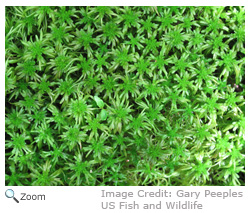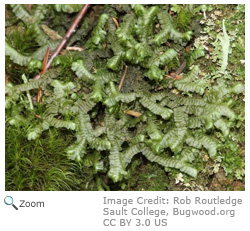Bryophytes |
Bryophytes have no roots, leaves or stems. Mosses, hornworts, and liverworts belong to this group. |
Mosses Mosses
are flowerless plants that grow in clumps. They don't have roots. Instead they have thin root-like growths called rhizoids that help anchor them. Because they don't have roots and stems to transport water, mosses dry out very quickly, so they are usually found in moist habitats. The only place they don't grow is in salt water. Mosses
are flowerless plants that grow in clumps. They don't have roots. Instead they have thin root-like growths called rhizoids that help anchor them. Because they don't have roots and stems to transport water, mosses dry out very quickly, so they are usually found in moist habitats. The only place they don't grow is in salt water. Moss plants are usually very small. They have leaf-like structures or phyllids that are usually only a single cell layer thick. The phyllids spiral around a stem-like structure called the caulid. Mosses reproduce in an unusual way. There is a first generation moss, the gametophyte. The gametophyte produces a sperm and an egg. They come together and grow into the next generation, the sporophyte. The sporophyte usually grows on a stalk or seta. The sporophyte has no chlorophyl and lives on a gametophyte. The sporophyte dries out and releases spores that grow into a new generation of gametophytes. |
Liverworts Liverworts get their name from their shape. In medieval times, people thought that the shape of a plant would tell you the part of the body it could help cure. Some liverworts look like the liver! Like moss, liverworts grow in moist habitats. They also don't have leaves, stems, or roots. Like moss, they use rhizoids to anchor themselves to the ground, rocks or trees. Liverworts get their name from their shape. In medieval times, people thought that the shape of a plant would tell you the part of the body it could help cure. Some liverworts look like the liver! Like moss, liverworts grow in moist habitats. They also don't have leaves, stems, or roots. Like moss, they use rhizoids to anchor themselves to the ground, rocks or trees.
HornwortsThere are about 100 species of hornworts in the world. They are found in tropical forests and along streamsides. They are usually small and greenish-blue. They are long and narrow and have sporophytes at their tips. The sporophyte is where the spores are made. When the spores mature, the stalk splits open and releases the spores.Images
|
